Царицыно доклад на английском
Обновлено: 05.07.2024
Представлен реферат по английскому языку на тему Москва. Достопримечательности/ Moscow. Sights с переводом читать бесплатно.
Кремль представляет собой средневековую крепость в самом сердце Москвы. Он состоит из многочисленных древних дворцов, соборов с золотыми куполами и Кремлевской стены с башнями. Ее великолепный архитектурный ансамбль возвышается над Москвой-рекой. Начиная с 1991 года, Кремль стал президентской резиденцией. К соседним достопримечательностям относятся Александровский сад и Красная площадь. Эффектный собор Василия Блаженного также расположен в центральной части города. Раньше он был церковью, а теперь служит в качестве музея. Здание напоминает пламя костра, которое касается неба. Его эстетическая красота и уникальность хорошо известны во всем мире. Останкинская телебашня находится в районе Останкино, в честь которого она и названа. Это одно из самых высоких свободно стоящих сооружений в мире. Построенная в честь годовщины Октябрьской революции, башня сегодня привлекает огромное количество любопытных туристов. Парк в Царицыно является одним из самых привлекательных исторических парков во всей России. Это романтическое и несколько таинственное место с псевдоготическим особняком расположено в южной части Москвы. Парк в последнее время претерпел большие ремонтно-реставрационные работы.
Moscow is the capital of Russia and its major political, cultural, scientific center. It is one of the largest cities in the world and the northernmost megacity on Earth. Moscow is situated in central part of the country on the Moskva River, after which it is named. Every year millions of people visit Moscow to explore its sights. It has a world-renowned architecture and many places of historical significance. The central attraction and the place that nobody misses is the Kremlin. It is one of the World Heritage Sites. Other than that tourists want to see the real masterpiece of Russian architecture – Saint Basil’s Cathedral, and many prominent landmarks including Ostankino Tower, Tsaritsyno Park, the Triumphal Arch, Novodevichy Convent, “Friendship of Nations” fountain, the Pushkin Museum of Fine Arts, the Bolshoi Theatre and, of course, Moscow Metro.
The Kremlin is a medieval fortress in the very heart of Moscow. It consists of numerous ancient palaces, golden-domed cathedrals and the Kremlin Wall with its towers. Its magnificent architectural ensemble stands high above the Moskva River. Starting from 1991 the Kremlin has become the presidential residence. Neighboring sights are the Alexander Garden and Red Square. The spectacular Saint Basil’s is also in the central part of the city. It used to be a church, but now serves as a museum. The building reminds the flame of a bonfire that touches the sky. Its aesthetic beauty and uniqueness are well-known in the world. Ostankino Tower is located in Ostankino district, after which the tower is named. It is one of the tallest free-standing structures in the world. Built to commemorate the anniversary of October Revolution, the tower today attracts a vast number of curious tourists. Tsaritsyno Park is one of the most attractive historic parks in all of Russia. Situated in the southern part of Moscow, it’s a romantic and somewhat mysterious place with a pseudo-Gothic mansion. The park has recently undergone a large-scale restoration.
The Triumphal Arch of Moscow is an architectural monument with a large solemn arch, which was built to mark the victory of Russian people in the Patriotic War of 1812. The earliest wooden structure was replaced by solid brick construction. The current arch is designed in the second half of the 20th century by Joseph Bove. Novodevichy Convent is a Russian Orthodox church founded in 1524 in honor of the conquest of Smolensk. Today, it’s an active cloister and historical museum. The “Friendship of Nations” fountain is one of the main symbols of All-Russian Exhibition Center. This grand structure of historical, cultural and national importance was built in 1954. It consists of 16 gilded female statues, each representing the former USSR republics. The fountain is nicely illuminated at night and looks mysterious. The Pushkin Museum of Fine Arts holds one of the largest foreign art collections in Russia. It presents the works of art from ancient times to the present day. There are more than 670 thousand at items there. Annual attendance is about 1 million people. One of the largest theatres in Russia, the Bolshoi Theatre, is of world significance in the field of opera and ballet. The complex of its buildings is located in the central part of Moscow, on Theatre Square.

Thousands of tourists from all over Russia as well as from abroad come to Moscow annually. But what can a tourist see in Moscow and where can a local citizen go? Despite the widely spread opinion the touristic Moscow does not end up with the Kremlin, on the contrary, it begins with it. There are plenty of beautiful and wonderful places to walk in Moscow. Tsaritsyno is one of them. One can come here for a day-time excursion, a mere walk on a warm summer evening or visit Tsaritsyno Museum. The last is suitable for those who would like to admire not only the outer but the inner interiors of the estate as well.
The Tsaritsyno Park is the conservation area and that implies a number of regulations to be in effect on its territory and compulsory for all visitors. Entrance to the Tsaritsyno Park with animals and on bicycles is prohibited. Detailed regulations are on the official web-site of the Tsaritsyno Museum-reserve.
How to Get to Tsaritsyno
There are two metro stations next to the Tsaritsyno Park: “Tsaritsyno“ and “Orekhovo”. While the place where you begin your visit is of no importance in the Kolomenskoe Park, this approach is not suitable for Tsaritsyno. A theatre begins with a coatroom and the Tsaritsyno Park – with the central gate. There is no doubt that one will never try to access a theatre by a backdoor in order not to miss the red carpet.
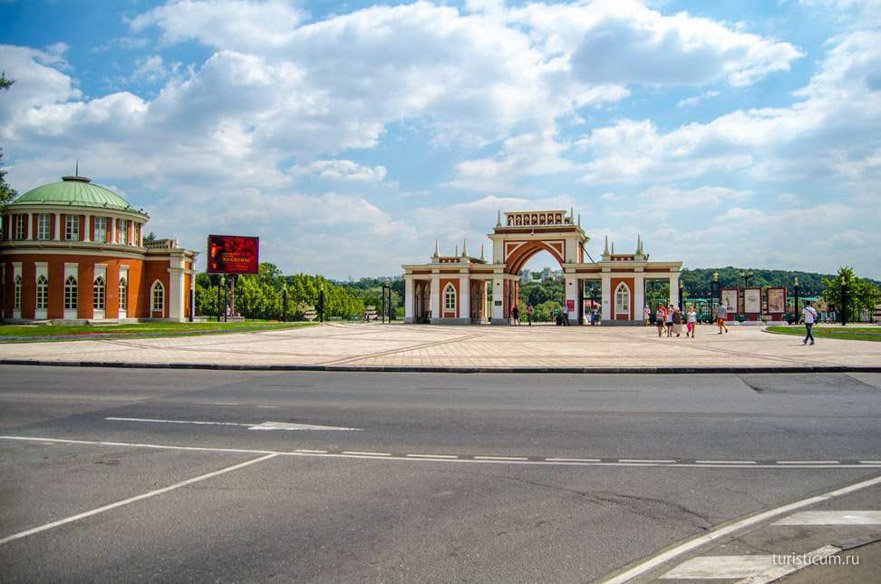
The central gate of the Tsaritsyno Park is close to the “Tsaritsyno” metro station. From the station pass under the Railway Bridge and here you are at the destination point. And after exploring the whole territory of the park you can leave it from the “Orekhovo” station which is close to the park exit. The territory of the park is so huge that after a walk along it and exploration of museum one might be too tired to return back to the “Tsaritsyno” metro station.
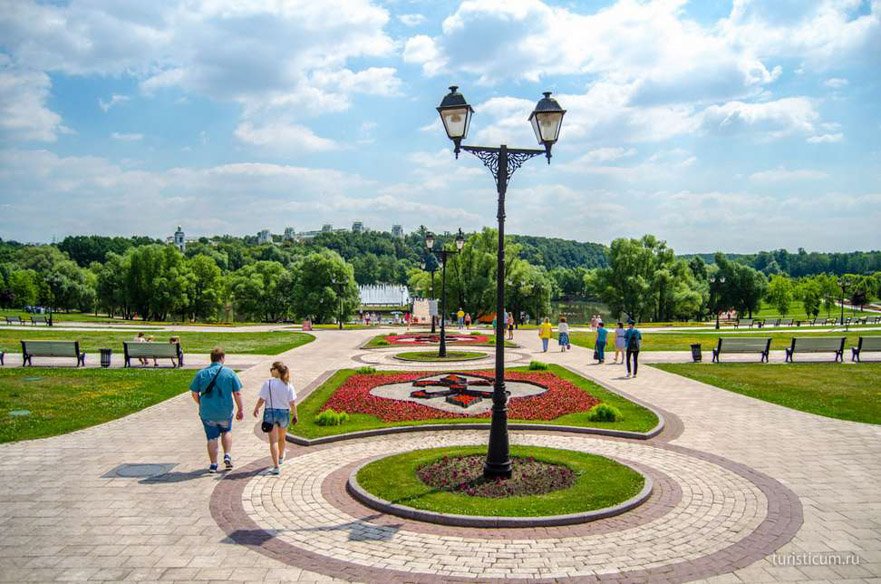
Behind the gate you find yourself in a fairy-tale. The entrance to the park separates us from reality and carries from a bustling metropolis to the 18th century. It is really hard to identify the century that time-machine has taken us to. Even the way flowerbeds are cut does not help us here. Not until we get to the Tsaritsyno park and estate. And here is a nice appetizer to begin with.
To our sight opens a beautiful composition of the Middle Tsaritsyno Pound with a little artificial island in form of a horseshoe and light and music fountain. In fact there are two bridges to the fountain. And the fountain itself is surrounded with benches. This lets everyone to enjoy the beauty of the colored sprays in comfort. But it is very hard to stay in the sun during the midday heat since there are no trees by the fountain, fortunately there is enough of shadow from the trees around the pound itself.
We go round the right part of the pound so that the Middle Tsaritsyno Pound remains on our left and the Upper Tsaritsyno Pound emerges on the right.
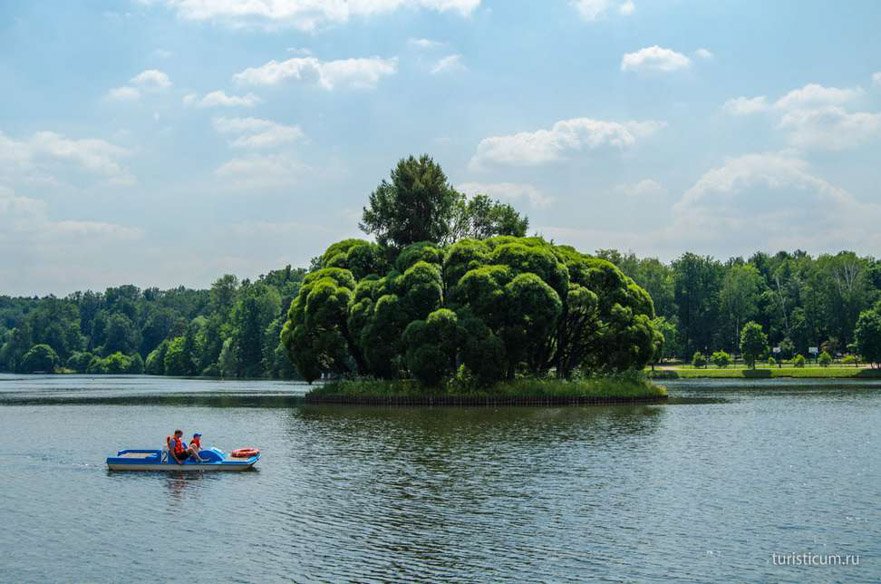
There is a little island called the Bird Island in this part of the pound. Besides, there are two more similar islands in the Upper Tsaritsyno Pound. The pound itself is quite big and walking round it will be a complicated thing to do.
There is a dam separating the Upper and the Middle Pounds.
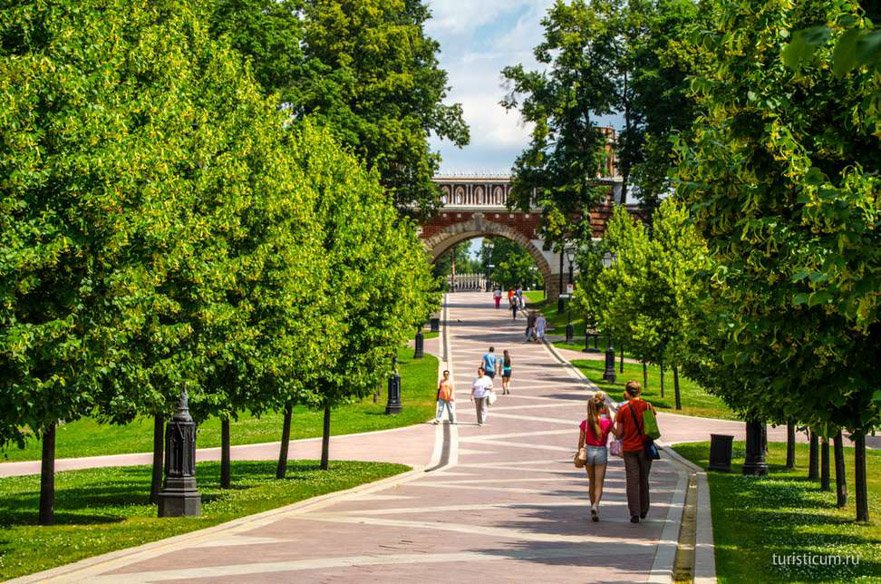
We go further, along Vozdushnaya Street and straight ahead to the most interesting – to Tsaritsyno park and estate. In order to get to the Tsaritsyno Palace one has to pass under the Figured Bridge. But there is also a chance to go along the bridge since there are stairs nearby. It should be mentioned the the Figured Bridge is one of the earliest buildings in Tsaritsyno; its architect was Vasiliy Bazhenov, who built both this bridge and the whole palace for the empress Catherine II.
Tsaritsyno palace and its buildings
The bridge was built at the crossing of the main entrances to the Tsaritsyno estate. As a result it may be considered the gate to the estate. And its fancy architecture makes it look like a real defensive construction with towers and loopholes. The bridge has survived perfectly save till our time, so today, when we look at the bridge we see it exactly the way Bazhenov intended and built it.
There is the building of the Third Cavalry Corps and the Russian Orthodox temple “Life-giving Spring” in Tsaritsyno on the left of the bridge.
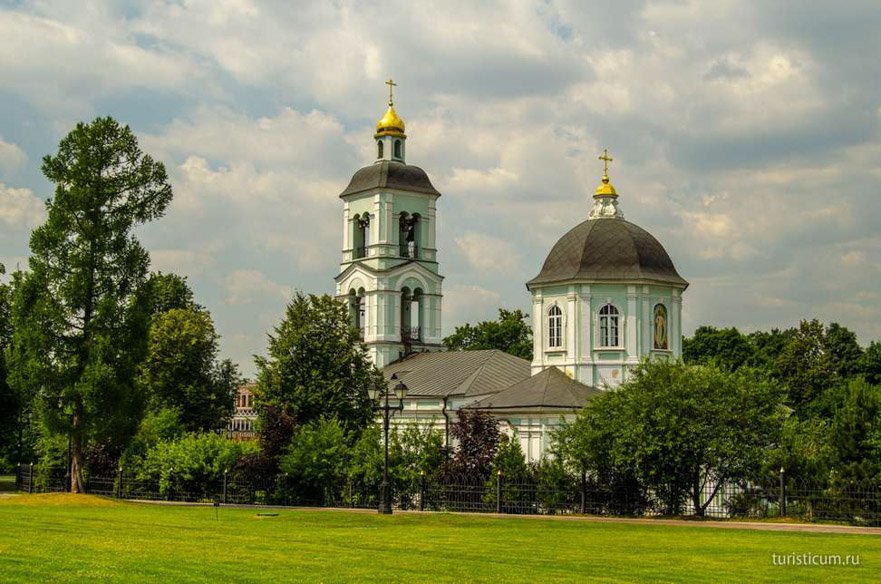
The first church appeared at this place in 1683. Later on stone building replaced the wooden one. Finally, in 1765 the cathedral was rebuilt last.
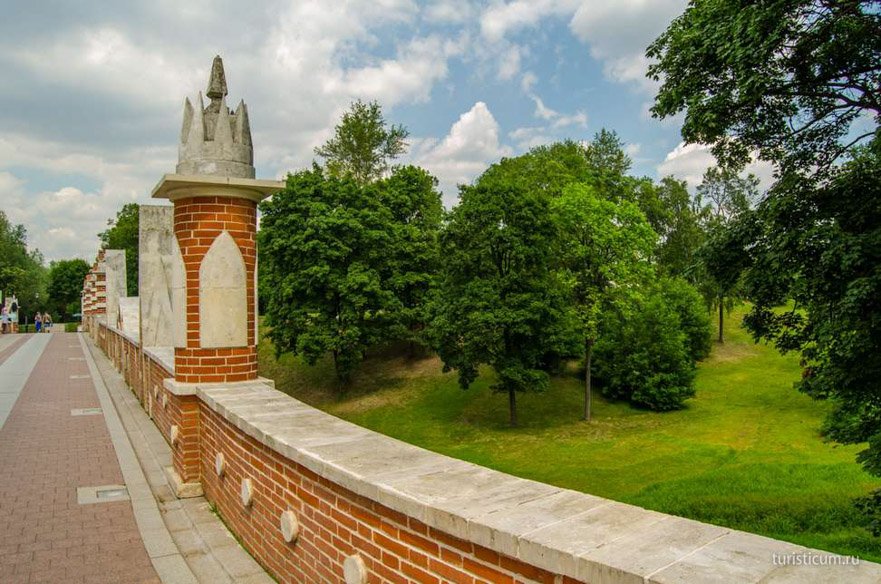
A bit further there is the Grand Bridge over a gulley. Bazhenov did not finish it since the empress estranged him from installation of her estate before the bridge completion. As a result it was only finished in the 19th century.
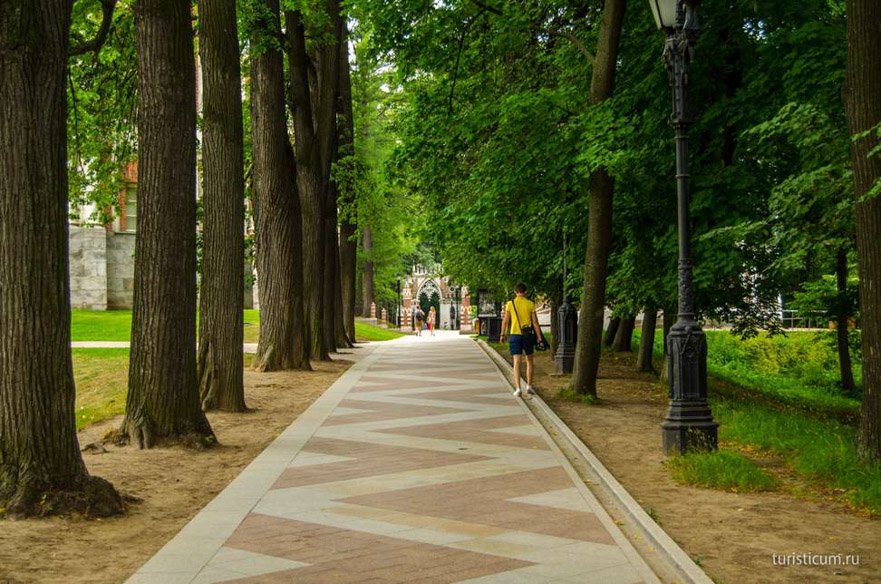
If we get back to the Figured Bridge, turn to its right, round the main palace, pass the Polutsirkulyarnyi Palace and the Opera House we will finally get to the Grape Gate. By the way, initially its name was figured. The name Grape appeared in the 20th century due to the fancy décor resembling a bunch of grapes hanging over the gate passage. The gate is a nominal border between the park and the estate. It also completes the developed prospect between the Grand and the Middle Bridges.
After the Figured Bridge we find ourselves in the middle of Tsaritsyno architectural complex. There is a number of basements in front of the Grand Palace. The basements of the Kammerjungfer Corps are on the right of the palace.
The basement of the Big Courtiers’ Corps is in front of the Tsaritsyno Grand Palace. Bazhenov built it in 1784. Later on in 1795 Kazakov the second architect of the Catherine’s palace dismantled the building.
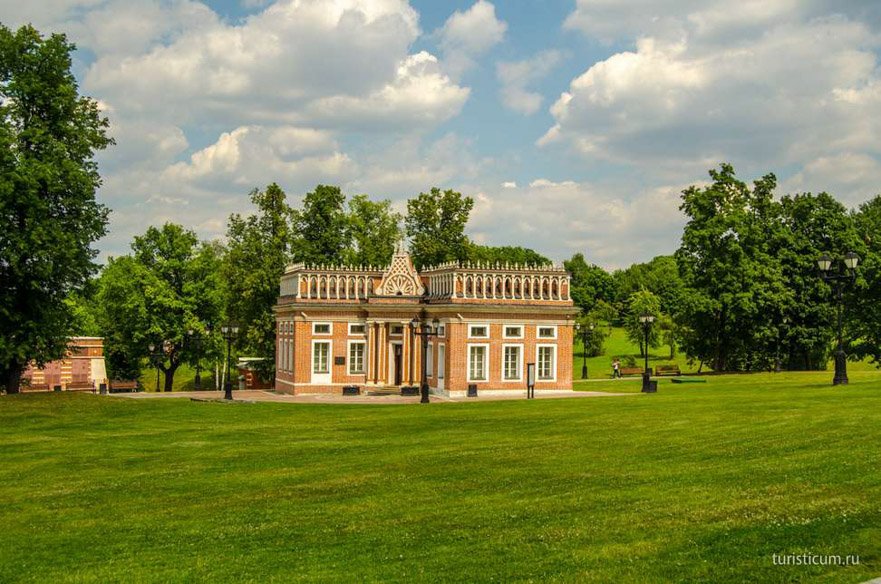
Bazhenov also built the First Cavalry Corps which is on the left of the Grand Palace.
The main pearl of the architectural complex is still undoubtedly the Grand Palace itself. A palace with history of destruction. The empress approved the project of Tsaritsyno architectural complex and in 1776 there began the tremendous construction that lasted for decades. The performance of the project was hard; Bazhenov even had to take on loans in care of his own self in order to complete the construction. Catherin II inspected the buildings in 1785 and the verdict was shuttering for Bazhenov. The empress positively disliked the palace. Catherin ordered to dismantle it. Matvey Kazakov, Bazhenov’s apprentice, became the new architect and started the construction of a new palace. The flow of construction was hard and slow. Catherine II died in 1796 by the time the Tsaritsyno Place had only been finished at the draft level.
This is the moment when the history of Tsaritsyno Palace withering began. None of the successors of the throne liked the palace and Tsaritsyno never turned into royal residence.
An arched gallery joins the Grand Palace with the Bread House.
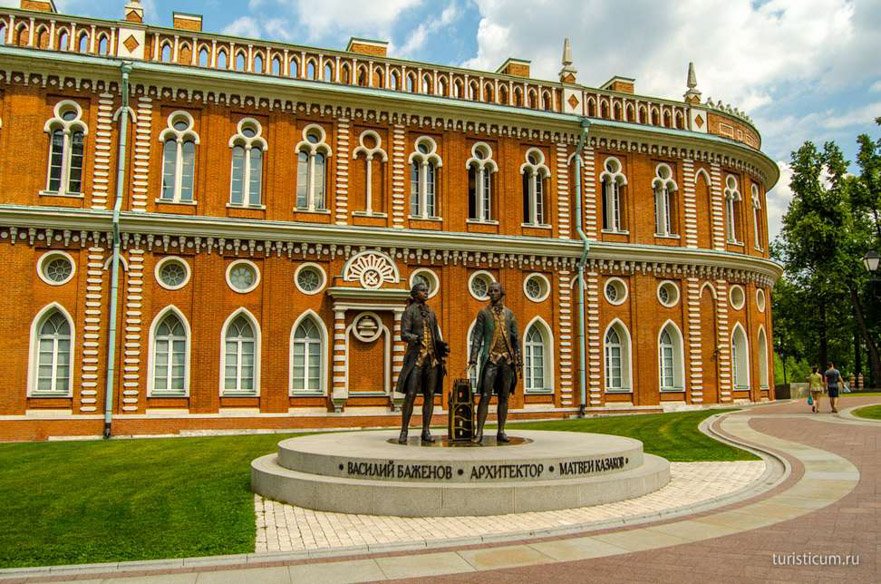
There is a memorial in front of the Bread House. It is devoted to the two architects – Bazhenov and Kazakov – both of whom worked at the construction of Tsaritsyno architectural complex in.
Tsaritsyno Museum
Here is also the entrance to the Tsaritsyno Museum. Visitors enter the indoor premises through subways. As a result, the palace is completely sealed from the outdoors. All the necessary information about the museum open hours and ticket prices is at the Tsaritsyno Museum official website.
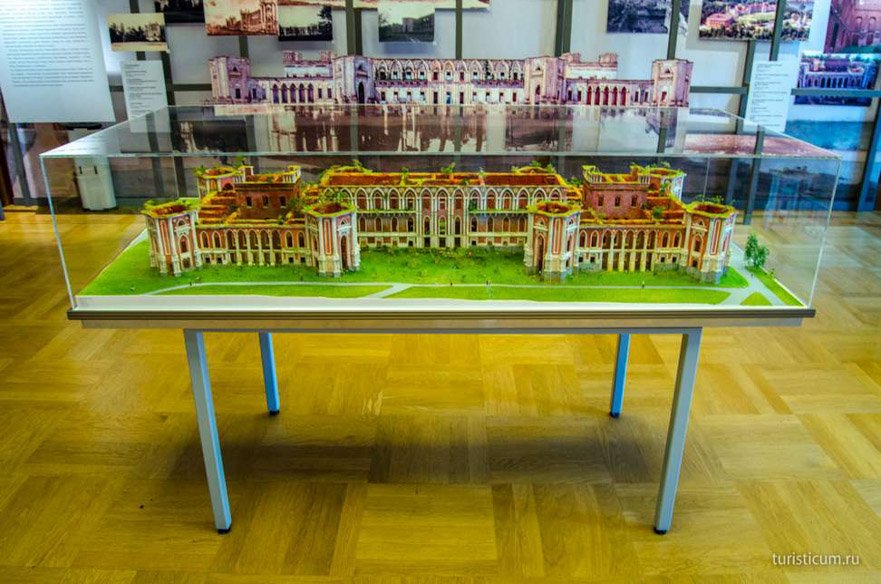
There is the model of the palace in the first museum room. It demonstrates the condition of the building in which conservators received it. It looks abandoned and deserted recalling an ancient prison. This is how the writer Nikolay Karamzin named it in 1816: “The palace looks like a dungeon”.
There are both permanent and temporal displays in the Grand Palace. It is prohibited to photograph the temporal displays. At the same time one can take photos of permanent displays without flash-light and trepied of course. Room with archeological evidences found on the territory of Tsaritsyno begins the display.
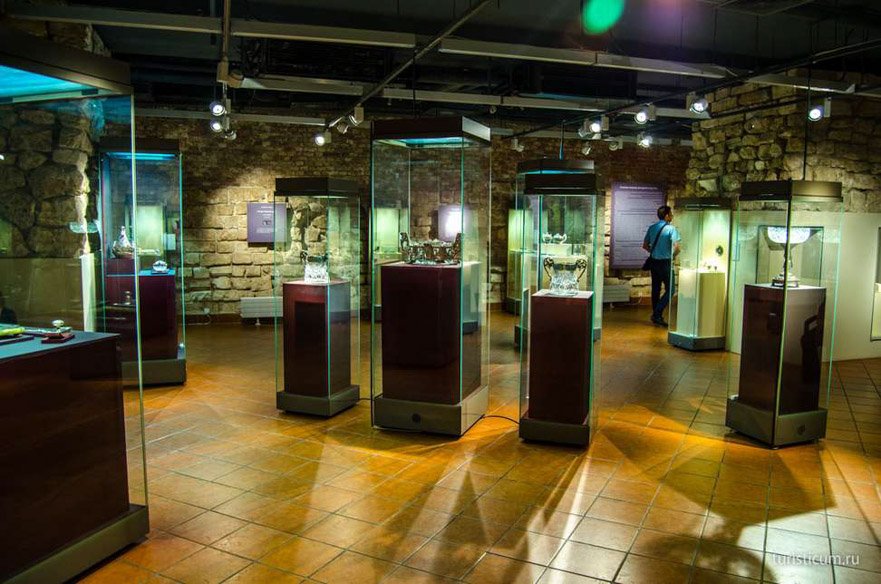
Another interesting display is the “Silver Treasury” of the palace. Here one can admire jewelries by famous jewelry masters and workshops from the 16th up to the 19th centuries.
Apart from the displays one can enjoy a mere walk along the renovated rooms of the palace. Though it is hard to imagine that someone lived and enjoyed life here – music never played and not a single ball was held at this place.
Picturesque views of the territory in front of the palace open from its windows.
Catherine Hall is the most luxurious of all the halls in the Grand Palace. It became the main hall of the palace after the reconstruction. And the mastermind of the construction Catherine II gave it her name. Parquet-flooring, cut-glass chandeliers, moulded decorations make the Catherine Hall fascinating.
The main decoration of the hall is the empress’ marble statue that weighs 3 tons (6613.87 lb.). The statue enriched the hall of the Moscow State Duma and had a miraculous escape after the Revolution in 1917.
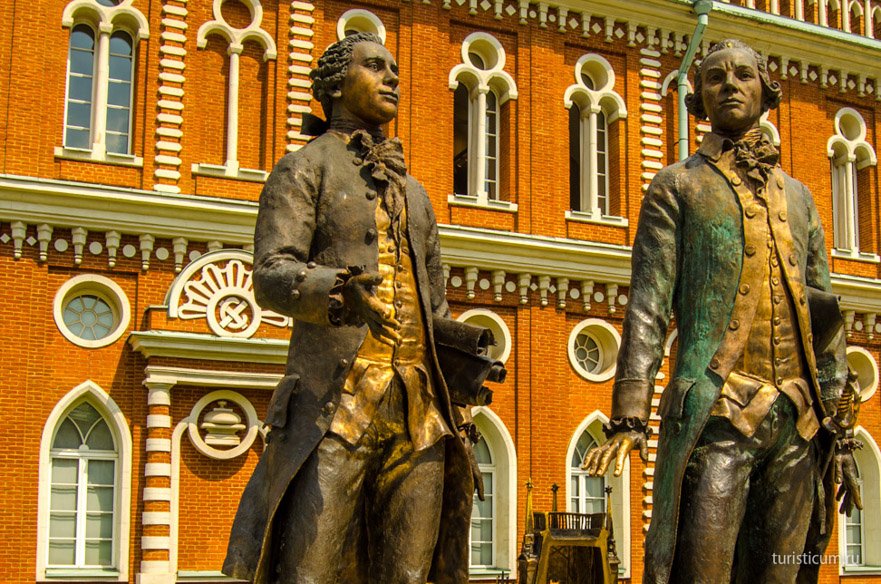
It took us above one hour to see all the displays in details. After enough of walks along the Grand Palace we went to the Bread House. The Bread House received its name in the 19th century after the high reliefs on its front – a loaf of bread with a saltcellar. Behind the backs of architects who built the Grand Palace one can see the high relief and cipher of Russian letters “X” and “C” (stand for хлеб – bread, соль – salt).
The cube building has a courtyard inside of it for carts with food supplies. Bazhenov did not have time to complete his plan due to the above mentioned reasons and the glass dome over the Bread House only appeared in 2005 having turned the courtyard into an atrium.
Tsaritsyno Park
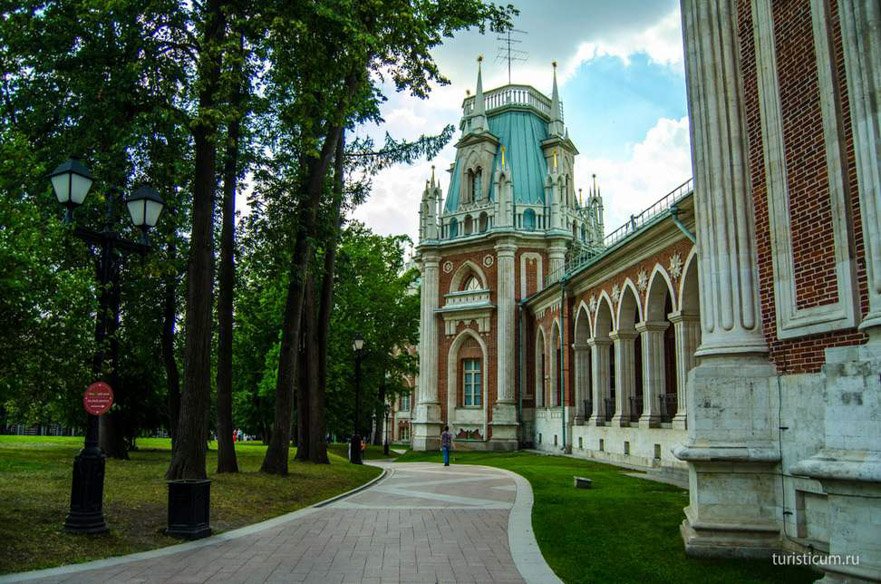
We leave the museum the same way as we entered it.
We find ourselves in the Tsaritsyno Landscape Museum – Reserve. Its territory is huge and one can walk along it as long as along the museum itself. But apart from the fascinating nature the park is also home for many artificial attractions and one can never get bored here.
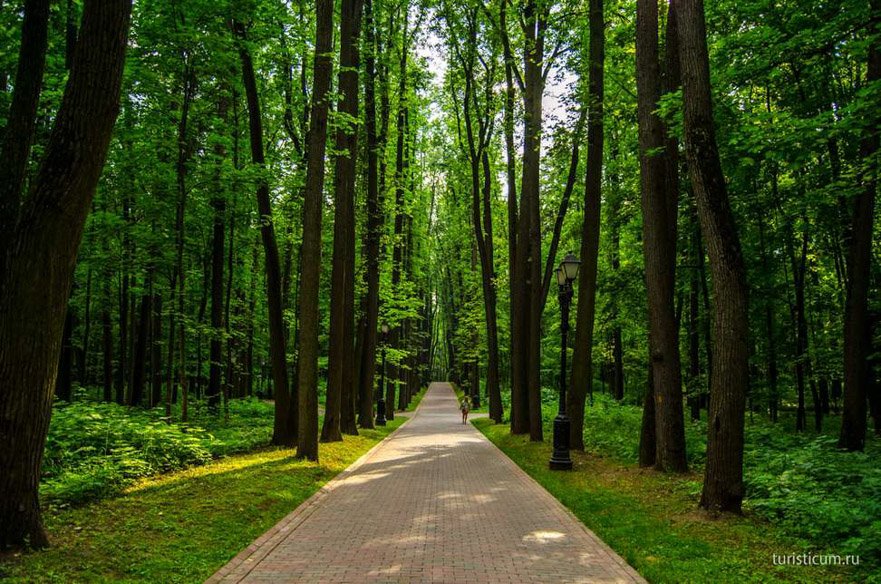
Even though here are information stands with the location map, it is quite easy to get lost. Even though here are much fewer people than in the front part of the reserve, they still do appear and can give directions to the exit, if needed. We went to walk over the hills and far away.
And the first “far away” attraction we walked into was the “Nerastankino” Pavilion. The pavilion was built in 1804 and served as a place to rest for promenade-makers. The “Nerastankino” Pavilion performs the same function even now; strollers hide from the midday heat and rest after exhausting walks in it.
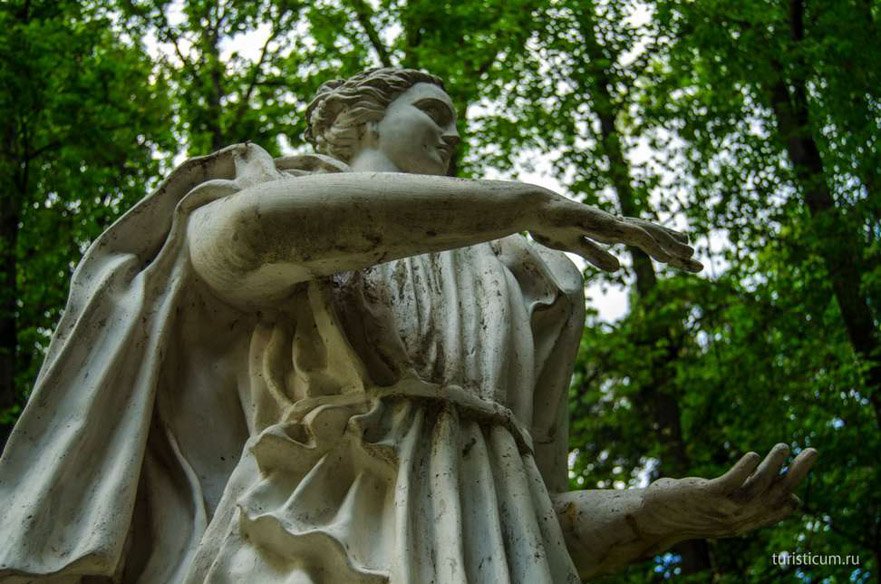
The Driada Statue is not far from the pavilion. There are several similar statues in the park.
Then our legs took us to the Ruin-Tower that was built with the decorative purpose the same year as the “Nerastankino” Pavilion.
Apart from the above described, in Tsaritsyno Park we also paid attention to the following attractions: the “Milovida” Pavilion, rotunda “Ceres’s Temple”, some decorative bridges and statues. All of them will only make it more interesting for you to walk along the beautiful park.
Walking along historic places is not only aesthetically delightful (providing these historic places are renovated and set in order), but also useful for overall development. For example, apart from the history of the Tsaritsyno estate itself it will be curious to find out the following. The first reminders of the place known as Tsaritsyno root back to the 16th century. Back then these places were called Black Mud. Later, the estate built by boyars Streshnevs also received this name. The owners changed and in March 1683 Aleksey Golitsyn – Ivan Streshnev’s grandson – became its owner and his descendant Leo Golitsyn in his turn became the main wine-maker of the Abrau-Durso Estate. Sergei Kantemir was the last owner from whom Catherine II bought the estate in order to build the palace.
It is extremely pleasant that such places as Tsaritsyno Museum – Reserve arise in people keen interest to history, desire to see and experience new places.
Вы можете изучить и скачать доклад-презентацию на тему Tsaritsyno. Презентация на заданную тему содержит 12 слайдов. Для просмотра воспользуйтесь проигрывателем, если материал оказался полезным для Вас - поделитесь им с друзьями с помощью социальных кнопок и добавьте наш сайт презентаций в закладки!












The most famous unfinished Moscow. The palace complex, whose construction started by Cerine II was completed only at the beginning of the 21st century. The most famous unfinished Moscow. The palace complex, whose construction started by Cerine II was completed only at the beginning of the 21st century.
The palace complex was built for many years. The first palace built by architect Vasily Bazhenov, did not like the Empress, so was demolished. In its place, the architect Matvei Kazakov built a new building. It has survived to the present day. The palace complex was built for many years. The first palace built by architect Vasily Bazhenov, did not like the Empress, so was demolished. In its place, the architect Matvei Kazakov built a new building. It has survived to the present day.
Today is a big park, where people come for a walk not only the residents of the surrounding districts of Moscow. At the entrance to the museum-reserve, visitors are welcomed musical fountain, which can be approached by two graceful bridges. Today is a big park, where people come for a walk not only the residents of the surrounding districts of Moscow. At the entrance to the museum-reserve, visitors are welcomed musical fountain, which can be approached by two graceful bridges.
At the entrance to the palaces appear stylized castle gates and towers. In the Opera House, which was built as a venue for receptions and balls, now hosts concerts of classical music, the various official events. At the entrance to the palaces appear stylized castle gates and towers. In the Opera House, which was built as a venue for receptions and balls, now hosts concerts of classical music, the various official events.
There are several permanent exhibitions on the history of the Tsarina and the reign of Catherine II. There are several permanent exhibitions on the history of the Tsarina and the reign of Catherine II.
Bread House ("Kitchen Building") - one of the most massive structures Tsarina. Two-storey building on a high base has a square shape with rounded corners. Bread House ("Kitchen Building") - one of the most massive structures Tsarina. Two-storey building on a high base has a square shape with rounded corners.
- Для учеников 1-11 классов и дошкольников
- Бесплатные сертификаты учителям и участникам

- Поможем развить концентрацию и внимание с раннего возраста
- Повысим гибкость и раскованность в общении
Описание презентации по отдельным слайдам:


Let’s play an interactive game “A trip to Tsaritsyno” to consolidate the knowledge of Tsaritsino. To begin with, choose the category of the question. Click the cell that you are interested in (the higher the number, the more difficult question) You will see a question that you must answer. Once you have answered the question check up that this answer by clicking on a slide. Then click again on the button to go to the slide on and choose the next question. Once you have answered all the questions, click on the "scoring" under the table and check how well you have learned the material and how well you have applied your knowledge in this field. Note: don't forget writing points for each correct answer!



YOUR SCORE HISTORY50100150200250300350 ARCHITECTURE50100150200250300350 BIOLOGY50100150200250300350 ART50100150200250300350 PONDS IN TSARITSYNO50100150200250300350

WHO AND WHEN BOUGHT TSARITSYNO? Back to questions ANSWER: CATHERINE II, IN 1775 .

What did Alexander II allow the walking public in 1856 by special Decree in Tsaritsyno? Back to questions Answer: it was allowed to drink tea, temporary tea-houses were built.

Why did such famous writers as Dostoevsky, Chekhov, Bunin, Tyutchev frequently visit Tsaritsyno in the 1870's? Back to questions Answer: because at that time there was a country village, these writers rented the summer cottages or stayed with their relatives.

When did the official opening of the reconstructed Palace take place? What was special about that day? Back to questions Answer: September 2, 2007 , it was the day of the city of Moscow.

Who was the owner of the Tsaritsyno estate after the death of Catherine II? Back to questions Answer: her son, Alexander I

How was that area called in the 18th century? Back to questions Answer: Black Dirt.

How was Tsaritsyno called after the October revolution? Back to questions Answer: the village of Lenino.

What period does the style of the ensemble Tsaritsyno refer to? Back to questions Answer: Pseudogothic, Russian Gothic.

Who said these words: "Construction is diabolical: it devours money, and the more you build, the more I want to build. This is a disease, like alcoholism . "? Back to questions Answer: Catherine II.

Name the author of the Great Palace of the Tsaritsino ensemble. Back to questions Answer: Matvey Kazakov.

What was Catherine II particularly impressed by at the Grand Palace in Tsaritsyno? Back to questions Answer: the dome of the Grand Palace.

Whom was the Empress inspired by to build the Tsaritsyno ensemble? Back to questions Answer: Prince Potemkin-Tavrichesky.

The architectural structure is on the top of a high hill with magnificent views of the Valley of the river Yazvenki. Initially a stone statue of the Roman goddess of fertility has been installed under its dome. Back to questions Answer: the Pavilion "Temple of Ceres", also called "Golden sheaf ".

The Palace was built as a royal residence for Catherine II. After 10 years of construction the tsarina tore the building down. Back to questions Answer: the main building of the Palace.

What mammals can we see in the park of Tsaritsyno? Back to questions Answer: Woody-squirrels.

What types of birds are the basis of fauna in Tsaritsyno? Back to questions Answer: the forest, water-birds.

What plant in this park is well known as the plant of happiness and associated with many legends. Back to questions Answer: Periwinkle.

Name the biggest and the oldest tree in the Park. Back to questions Answer: the oak.

Name the smallest beast of prey on the territory of the Tsaritsyno estate. Back to questions Answer: Weasel.

Name one of the Primroses which is widespread in the museum-reserve Tsaritsyno. Back to questions Answer: Anemone.

Plant which is listed in the Red book of the city of Moscow and flowering from June to late autumn? Back to questions Answer: Carnation Fisher.

In what of his novels did I.S. Turgenev describe the Tsaritsyno ponds? Back to questions Answer: the novel “The Eve"

The great Russian writer created the famous play when he heard about cutting down the orchards in the estate of Tsaritsyno. Back to questions Answer: A. P. Chekhov “The Cherry Orchard"

A famous singer who visited Tsaritsyno. Back to questions Answer: F. I. Shalyapin

The artist, who painted this picture,often visited Tsaritsyno. Back to questions Answer: M. A. Vrubel

The author of “The Stories of ABC” who visited Tsaritsyno. Back to questions Answer: Leo Tolstoy

In one of his works the writer I.V. Kireevsky mentioned "great ponds", their "calm waters", "rough, narrow road, bridge," distant fields and groves, riding in the boat, "a musical splash of water, fresh air, darkly poetic view of the surrounding garden, restaurant, dinner, ordered in it. What is the object -world? Back to questions Answer: The night of Tsaritsyno

Sculptures of two of the most famous Russian architects of the 18th century are near the Grand Palace of the Museum .They built the ensemble of Tsaritsyno. Who are they? Back to questions Answer: Kazakov and Bazhenov

The Borisovsky pond is the oldest pond in Tsaritsyno. When did this pond appear? Back to questions Answer: during the reign of Boris Godunov.

In the middle of the 18th century the artificial islets were sprinkled in the Upper Tsaritsyno pond. Why was this done? Back to questions Answer: for the purposes of breeding waterbirds.

The Upper Tsaritsyno pond is famous for its picturesque bays. The largest one is located in front of the Pavilion "Khram”. When and where was this Bay formed? Back to questions Answer: in the mid-17th century, in the Meadow of the floodplain of the river Cherepishka.

The area of the largest pond is about 60 hectares. What is this pond? Back to questions Answer: Shipilovsky pond

What is the name of the pond in the Centre of it there is a large man-made island with a dense Grove? Back to questions Answer: the Upper pond

On the bank of the pond there are pavilions of “Khram” and “Nerastankino”. What is this pond? Back to questions Answer: the Upper Tsaritsyno pond

Name the pond in the photo Answer: the Middle Tsaritsyno pond

Oh well, calculate your number of correct answers and the amount of their points Now let's check how well you know the Tsaritsyno district: If the sum of your points is from 5500 to 7000, we congratulate you! This is a great result. You coped with the task perfectly! If the sum of your points is from 4000 to 5450, your result is good. Congratulations! If the sum of your points is from 2000 to 3950, then your results are satisfactory, but improve your knowledge, it can't hurt. If the sum of your points is from 0 to 1950, then your result is very bad. You should read more books on the topic.
Краткое описание документа:
Цель презентации "Путешествие по Царицыно" - систематизация и обобщение пройденного материала, а также представление результатов информационно-поисковой деятельности.Тип завершающего урока - урок контроля, оценки и коррекции знаний.Форма проведения - компьютерная презентация. Формирование коммуникативной компетенции решается за счёт развития её составляющих: социокультурной компетенции (приобщение к культуре, традициям и реалиям родной страны ирегиона проживания, умения рассказать о своей малой родине), языковой компетенции (овладение новыми языковыми средствами в соответствии с тематикой)
Читайте также:

